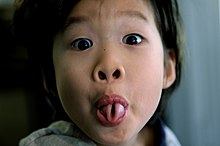Tongue rolling

Tongue rolling is the ability to roll the lateral edges of the tongue upwards into a tube. The intrinsic muscles allow some people to form their tongues into specific shapes. Popular belief holds that variation in this ability is the result of genetic inheritance. Rolling the tongue into a tube shape is often described as a dominant trait with simple Mendelian inheritance, and it is commonly referenced in introductory biology courses.[1]
There is little laboratory evidence supporting the hypothesis that tongue rolling is inheritable and dominant. In 1940, Alfred Sturtevant observed that ~70% of people of European ancestry could roll their tongues and the remaining ~30% could not do it.[2] A 1975 twin study found that identical twins were no more likely than fraternal twins to both have the same phenotype for tongue rolling.[3]

Cloverleaf tongue is the ability to fold the tongue in a certain configuration with multiple bends. To the extent to which it is genetic, it is probably a dominant trait distinct from tongue rolling.[3]
Recessive phenotype (r) and corresponding allele frequency (qr)
| Population | N | r % |
qr |
| Bosnia and Herzegovina | 9.069 | 42,99 | 0,66 |
| China | 1043 | 37,78 | 0,61 |
| Croatia | 114 | 36,34 | 0,60 |
| Hungary | 1.102 | 51,92 | 0,72 |
| Japan | 19.186 | 24,72 | 0,50 |
| Montenegro | 710 | 32,54 | 0,57 |
| Slovakia | 3.147 | 45,63 | 0,68 |
| Serbia - (Užice) | 2.217 | 52,37 | 0,72 |
| USA | 865 | 26,36 | 0,51 |
| Voivodina, region in Serbia | 6.132 | 42,60 | 0,65 |
See also
References
- ^ Mader S. S. (2000): Human biology. McGraw-Hill, New York, ISBN 0-07-290584-0; ISBN 0-07-117940-2.
- ^ Utah. "Observable Human Characteristics". Retrieved 26 January 2015.
- ^ a b Omim - Tongue Curling, Folding, Or Rolling
- ^ Hadžiselimović R. (2005): Bioantropologija - Biodiverzitet recentnog čovjeka / Bioanthropology – Biodiversity of recent man. Institut za genetičko inženjerstvo i biotehnologiju (INGEB), Sarajevo, ISBN 9958-9344-2-6.
- ^ Hadžiselimović R., Berberović Lj., Sofradžija A. (1980): Populacijska genetika sposobnosti savijanja jezika u žlijeb u stanovništvu Bosne i Hercegovine / Population genetics of tongue rolling in the population of Bosnia and Herzegovina. Glasnik Antrop. dr. Jug. / Bull. Anthr. Soc. Yug., 17: 87-95.
External links
- OMIM - Tongue Curling, Folding, Or Rolling
